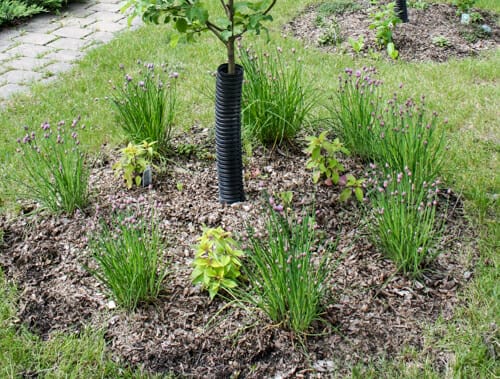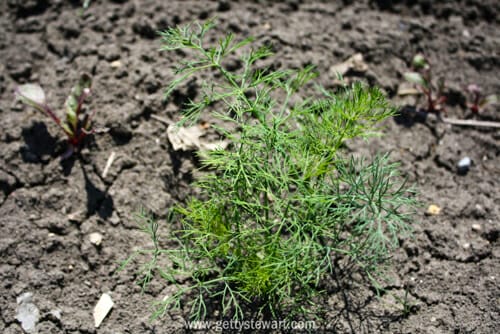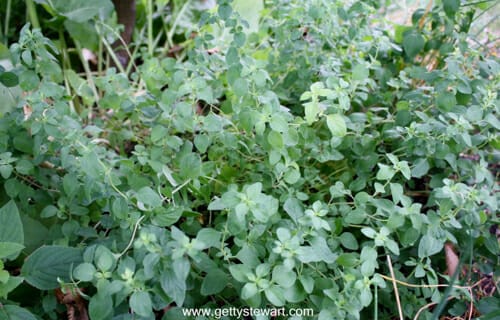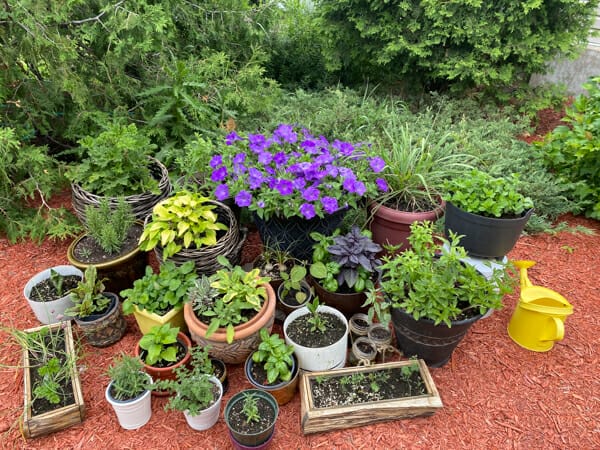Top Seven Cooking Herbs for Your Garden
My top seven cooking herbs for your garden. This list of favourite culinary herbs was not easy to put together. In fact, I just updated it from five to seven and still, there are many more I’d like to add! To me, fresh herbs are like icing on a cake, they transform a great dish into an extraordinary one, especially when they’re homegrown, freshly cut herbs.

Also Read: Top Tea Herbs for Your Garden, Grow Your Own Seasoning Blends, How to Muddle Herbs for Beverages
The variety of colours, textures, scents and flavours of herbs is endless. You can get shrubby ones, sleek ones, creeping ones, tall ones, variegated ones, dark ones, light ones and so on. Not only do they make your food taste great, but they can also create a beautiful, interesting garden space. Many also attract beneficial bees, butterflies and other helpful insects. And some repel pests like mosquitoes, carrot flies and aphids.
Yes, herbs also offer medicinal benefits. But that’s not my main goal or purpose of growing herbs. While I may have a cup of chamomile or mint tea to relax or soothe an upset tummy, I do not have the knowledge to share more insight into the medicinal world of herbs. If you are interested in this aspect, I urge you to be cautious and do plenty of research before consuming any one herb or herb blend in high amounts. As much as they can be beneficial, any plant taken in high doses can also cause negative side effects.
Personally, I grow herbs for the flavour and the sheer pleasure I get from all stages of growing, harvesting, preserving and using herbs. There’s something magical about pulling out your homegrown herbs in the middle of winter to add amazing depth of flavour to whatever you’re making. The fact that there are health benefits to doing so is an awesome bonus to me.
Top Seven Cooking Herbs to Grow
If you’re new to growing herbs, here are seven herbs that are easy to grow and very popular in the kitchen. Most of these herbs prefer direct sun with at least 6 hours of light and well draining soil with consistent but not too frequent watering.
1. Chives
Some people wait for tulips to signal the arrival of spring – I wait for the day I can dash outside and snip a few chives to add to supper. Check out my articles on Growing Chives and 12 Chive Recipes that I love.
- one of the mildest members of the onion (allium) family
- a perennial that is one of the first plants to come back in spring
- can be cut repeatedly throughout the season with new shoots growing back
- while it stays around all year, it is at its best in early spring and again in fall when temperatures are cooler, it does not enjoy the heat of summer
- cut and preserve chives by drying or freezing, flavour fades, but if you have lots, go for it
- grows in clumps about 12″ wide and 12 to 18″ high
- beautiful mauve coloured blossoms that can be used as a garnish, to infuse vinegar or in baking like in these chive biscuits
- direct seed into the garden or start 4-6 weeks prior to the last frost free day then transplant into containers or into the garden
- OR if you have a friend with an established patch of chives, ask them if you can slice off a small section of their chive roots to transplant into your garden. Chives are very hardy and will easily tolerate being split and moved.
- remove dead flowers to prevent self-seeding or be prepared for chives popping up everywhere!
- use chive greens or blossoms in salads, dressings, dips or on top of baked potatoes

2. Dill
Where would pickles, borscht, salmon, baby potatoes and egg salad be without dill? Growing up in a German household, dill, next to parsley and chives, was probably the most common herb I grew up with.
- dill is a fast, eager, self-seeding plant which reseeds itself without any hesitation or thought about your gardening plans; luckily, it is very easy to pull if it gets too carried away
- its narrow stems and fern like leaves grow 16 to 24″ high
- dill is harvested for it’s tender fern like leaves and for dried seeds at the end of the season How to Harvest Dill
- tiny white to yellow flowers form on umbrels and quickly turn into brown seeds that will disperse and come up within the same season or the following year
- direct seed into the garden after the danger of frost has past as dill prefers warm soil
- dill does not transplant well – so do not seed indoors
- it is easy to dry dill, but dried dill does not keep its flavour long, it is best to Freeze Dill for use throughout the year

3. Parsley
Parsley should be a staple in your garden. Not only is it great for garnishing just about any dish, but its curly bright green leaves make an attractive border for flower beds or planters. And, did you know you can use parsley as a breath freshener at the end of the meal? Of course you need to grow this herb in your garden!
- beautiful intense green colour, in curly or flat leaf varieties which are equally tasty
- can be cut repeatedly for use throughout the season How to Harvest Parsley
- grows in mounds about 8-24″ tall and wide
- parsley is a biennial, meaning it will come back a second year to form seeds; however, in our Zone (2b-3) it may not come back at all and if it does, most of its energy will be directed into seed production and therefore will not be as full and as bushy as in its first year, it is best to plant a new plant each year
- makes an attractive border in gardens and attracts swallowtail butterfly caterpillars (black and green stripes with yellow dots)
- parsley has a very long germination period (4-6 WEEKS) and a tough seed coating making it tricky to start from seed – be patient or start with transplants from a garden centre
- soaking the seed in warm water overnight will help soften the seed coating
- direct seed into the garden when soil is warm and all danger of frost has passed
- if starting indoors, use deep containers to allow tap root to grow and avoid damage during transplanting
- parsley can be dried, but it loses flavour quickly, I prefer Freezing Parsley

4. Basil
Basil is not something I grew up with, but now, I can’t imagine a garden without it. There are so many great recipes with basil.
- basil comes in several varieties with the most common being the sweet basil or Genovese basil with large green, shiny leaves. Two other must have basil varieties in my garden are purple basil and Thai basil which I use in my Thai Red Curry
- regular pruning will grow a full, luscious basil plant and leads to repeated cuttings How to Prune & Harvest Basil
- snip off flower heads to encourage continued growth and to get best flavour from leaves
- direct seed into garden or containers after all danger of frost has past or start 4-6 weeks prior to the last frost free day then transplant
- basil will not tolerate any frost either in spring or fall
- Here are 6 Ways to Store and Preserve Basil

5. Oregano
Another herb that I use frequently in my kitchen today but that was not a part of my childhood experience is oregano. Now, whenever Italian or Greek dishes are on the menu, my homegrown, dried oregano is sure to be part of the picture.
- oregano comes in several varieties – but for best flavour look for Origanum vulgare; other varieties including golden oregano or variegated oregano make and attractive border in the garden
- can be cut repeatedly for use throughout the season, best flavour is just as it is flowering
- oregano is a perennial, but because of our climate, it doesn’t always return every year, that’s why here in the prairies we often grow it like an annual (I always consider myself lucky if the previous year’s oregano makes an appearance)
- if your oregano does come every year, split or divide it every 3 years to rejuvenate it and bring back its full flavour
- retains its flavour very well when dried How to Harvest and Dry Oregano
- direct seed into garden or containers after all danger of frost has past or start 4-6 weeks prior to the last frost free day then transplant

6. Thyme
Thyme is an underrated yet very common cooking herb. Cooking thyme adds a delish savoury flavour to soups, grilled meats, roasted vegetables and various potato dishes. Other thyme varieties like orange or lemon thyme add exotic citrus flavour to those same dishes or to beverages or sweets like Lemon Thyme Cookies or to beverages like this muddled Lime Thyme Mojito.
- a woody perennial that grows in low, dense mounds or mats
- thyme has tiny little leaves and its flowers are equally delicate white, pink or mauve blossoms that pollinators love
- there are over 300 varieties, all of which are safe to eat but some are definitely preferred for cooking while others do better for ornamental landscaping
- favourite cooking varieties include common, summer, French, German or lemon thyme (several lemon varieties), check the tag to ensure its hardy for your garden zone so it comes back year after year
- for ornamental thyme that can be stepped on try creeping thyme or wooly thyme
- another favourite of mine for fresh beverages or desserts is orange thyme – what an aroma!
- thyme dries beautifully, so at the end of the season, be sure to dry your thyme to use throughout the winter
- like most herbs, thyme prefers sun, but it’s such a forgiving herb to grow that it will tolerate some shade
7. Rosemary
Rosemary is one of my favorite herbs to smell. I love that wonderful evergreen scent. Not every dish can handle that robust aroma – but those that do are amazing.
- a savory deep piney flavor that pairs well with roasted meats, potatoes and breads – anything that can handle a bold savory type flavor
- rubbing the leaves to release the scent is very pleasant and may, as more and more research is suggesting, stimulate memory, improve mood, and increase alertness (National Library of Medicine)
- a woody perennial with pine like needles, the plant can vary from tall upright bushes to low, spreading shoots that will drape over containers
- flowers vary with variety – typically pink, mauve, purple or blue
- rosemary loves warm climates and can not stay outside where frost hits – zone 8 is the typical limit, in cooler gardening zones, the plant has to be overwintered inside or grown as an annual
- it’s not the easiest herb to start from seed, best to get a seedling
- dries beautifully, read How to Cut and Dry Rosemary
- Try it in these recipes: Rosemary Focaccia, Rosemary Roasted Potatoes, Rosemary Simple Syrup for a Pina Romera
Other Cooking Herbs
Other herbs worthy of adding to your culinary herb garden include:
- cilantro/coriander (one of the most difficult to grow because it bolts so quickly)
- stevia – the natural sweetener
- sage – multiple varieties
- fennel
- lavender
- mint – multiple, interesting varieties (be careful, some mint varieties are very aggressive perennials)
- chamomile
- anise hyssop (a prairie native in the mint family) – makes amazing tea
- marjoram
- sorrel
- borage
Choosing the top five herbs out of that list was tough! What are your favourite herbs to grow and/or cook with?
More Articles on Herb Gardening
Here are a few other How To’s to get your herb gardening going:
- Grow Your Own Seasoning Blend
- Grow Your Own Herbal Teas
- Using Herbs in Cocktails and Mocktails
- How to Make Tea with Herbs
- Growing Chart for Herbs
- How to Make Iced Tea with Fresh Herbs
- When to Plant Different Vegetables

Share your favourite herbs in the comments below or share photos of your herb garden with me on Instagram @getgettys or Facebook @GettyStewart.HomeEconomist.



After parsley and dill my favourite herb is summer savory. In Germany it is called “bean herb” and is a great addition to any kind of casserole or soup made with dried beans, split peas, lentils etc. I use it instead of sage in chicken stuffing (sage seems too strong to me – I save it for sausage or pork patties.) Also nice with dill for stuffing and baking a whole whitefish. Very good with venison as it calms any gamey taste
, same with liver and pork roast. A little goes a long way, kind of like rosemary; too much and it all tastes like Christmas tree, lol. (Nope, not a big Jamie Oliver fan.) I was surprised to see how very expensive it is to buy, but there is not a lot of leaf on it, mostly little woody stems, but they are fine to toss into the pot and just remove them before serving. Before frost I cut the whole plants at the base, run a string through them, and hang to dry in a cool room or basement. Then I just cut sprigs whenever I need them.
Hi Corrie,
Thanks for sharing your insight. I grew and dried summer savory last year. I’ve put it in stews and soups – so great. I love your other suggestions, thanks!
This year I tried cuttings from the grocery store. Bought rosemary and placed in water. After a couple weeks, some had roots, planted them all. Success rate was about 50%, but still much faster than planting from seed. I also always save one mint plant each fall, regular mint and pineapple mint root very well in water. Hope this adds to your wonderful site for gardening in Manitoba.
Great tip, thanks Dodie.